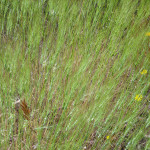Gallery:
- Aegilops triuncialis seeds
- Aegilops triuncialis awns and florets
- Aegilops triuncialis infloresence
- Aegilops triuncialis growth habit
Common names:
barbed goatgrass
Scientific Name:
Aegilops triuncialis (syns. Aegilops squarrosa)
Description:
Barbed goatgrass grows 8 to 16 inches tall with few to many culms. Leaf sheaths contain white hairs when young, becoming more or less smooth once matured. The blades are rigid, sharp, and spreading. Immature spikes are often reddish or purplish. Mature spikes are cylindrical and disperse from the parent plant as joined units at maturity, eventually breaking down to release their seeds. Grains are 1/4 inch long, resembling a wheat kernel.
Life cycle:
Height of mature plants
8-16 inches
Flower color:
N/A
Bloom time:
Typically blooms during May, June, and July.
Look-a-likes:
Aegilops ovata and Aegilops cylindrica are in the same genus as barbed goatgrass and are also listed noxious weeds in Oregon.
Habitat:
Barbed goatgrass invades rangeland, grasslands, and oak woodlands. This species is highly invasive in northern California.
Impacts:
When mature, barbed goatgrass is unpalatable to livestock and can cause injury to grazing animals. Goatgrass infestations can reduce forage quality and quantity by 50 to 75 percent. Because livestock tend to avoid this weedy grass dense stands form that push out natives and desirable forage. Barbed goatgrass is an agricultural concern since it can readily cross with wheat, producing sterile seed and unmarketable wheat.
Noxious Weed Listing:
- WeedWise: Priority
- State of Oregon: Class A,T
- State of Washington: Not listed
- Four County CWMA: Not listed
Origin:
This species is native to Western Asia and Mediterranean Europe.
Present in Clackamas County:
No
Links:
Oregon Noxious Weed Profile
USDA Plants
Global Invasive Species Database




